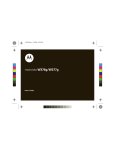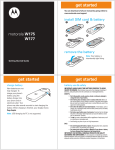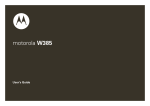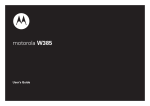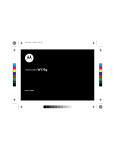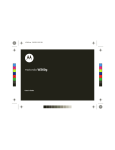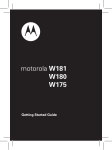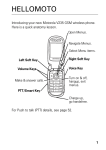Download Motorola W362 Product specifications
Transcript
motorola W362 Getting Started Guide get started install RUIM card, memory card, & battery 1 Remove cover. 2 Insert RUIM card. 3 Insert an optional microSD memory card. 4 Insert battery. 5 Replace cover. get started charge battery New batteries are not fully charged. Plug the battery charger into your phone and an electrical outlet. Your phone might take several seconds to start charging the battery. When finished, your display shows Charge Complete. For tips on battery life and charging, see “battery tips”. get started turn phone on & off Press and hold P for a few seconds, or until the display turns on or off. make a call Enter a phone number and press N. answer a call When your phone rings and/or vibrates, press N. end a call Press P. basics basics your phone Charge phone, connect to computer. Listen to music. Right Soft Key Volume Keys Smart Key Turn on & off, hang up, exit menus. Left Soft Key Open menus. Make & answer calls. Navigate menus. basics menus 1 Press the center key M to open the Main Menu. 2 Press the navigation key S up or down to highlight a menu option. 3 Press SELECT (the left soft key) or the center key M to select the highlighted option. Select basics emergency calls To call an emergency number: Press keypad keys to enter the emergency number, then press N to call it. Your service provider programs one or more emergency phone numbers (such as 112 or 911) that you can call under any circumstances, even when your phone is locked or the RUIM card is not inserted. Note: Emergency numbers vary by country. Your phone’s preprogrammed emergency number(s) may not work in all locations. Sometimes an emergency call cannot be placed due to network, environmental, or interference issues. basics status indicators Status indicators show at the top of the home screen: Signal Strength 1X Active Roaming Active Active Call 5 I W h É õ S Motorola n - É M Headset Active Alert Type h 10/15/08 SETTING Battery Level 05:05pm MYMENU New Message Note: Your phone’s home screen may be different than the one shown above. basics voicemail Find it: M > e Messages > Voicemail recent calls Find it: M > s Recent Calls Tip: Press N from the home screen to see a list of dialed calls. lock your keypad To prevent accidental key presses, lock the keypad: Press the center key M, then (within two seconds) press *. Press the same keys again to unlock. basics menu map n Phonebook s Recent Calls • • • • • e É Missed Calls Received Calls Dialed Calls Silent Scratch Pad* Call Timer Messages • Create Message • Inbox • Outbox • Voicemail • Drafts • Templates • Broadcast Msgs* Tools • Calculator • Stop Watch • Lantern • Datebook • Alarm Clock • MyMenu • Reserved Call* • World Clock • Service Dial* Q Games & App Æ Music Player h Multimedia • • • • • Camera Pictures Sounds Voice Records FM Radio - Brew w Settings • Ring Styles • Phone Status • In-Call Setup • Security • Personalize • Initial Setup • Network • Airplane Mode • Headset • Connection * Network dependent Standard main menu layout. Your phone’s menu may be different. customize change your phone’s ring To change ring volume: Find it: M > w Settings > Ring Styles > Style Detail 1 Scroll to Ring Volume and press CHANGE. 2 Press S right/left to raise/lower volume. To change ring style: Find it: M > w Settings > Ring Styles 1 Scroll to Alert: and press CHANGE. 2 Scroll to the style you want and press SELECT: õ Loud Ring Î Vibrate ö Vibe then Ring ô Ì Í Soft Ring Vibe and Ring Silent customize set phone to vibrate Find it: M > w Settings > Ring Styles Scroll to Alert: and press CHANGE, then scroll to Vibrate and press SELECT. set wallpaper & screen saver Find it: M > w Settings > Personalize > Wallpaper Find it: M > w Settings > Personalize > Screen Saver 1 Scroll to Picture and press SELECT. 2 If you have an optional memory card installed, choose to view pictures on the Phone or Memory Card and press SELECT. 3 Press S up or down to scroll to a picture and press SELECT. Select [None] to turn off wallpaper or the screen saver. Tip: To extend battery life, turn off the screen saver. phonebook store phonebook entry To store a phone number in your Phonebook: 1 Enter a phone number in the home screen and press STORE. 2 Enter a name and other details for the phone number. To select a highlighted item, press CHANGE. 3 Press DONE to store the entry. call a stored number Find it: M > n Phonebook 1 Scroll to the entry you want to call. 2 Press N. text messages send a text message Find it: M > h Messages > Create Message 1 With To: highlighted, press CHANGE. 2 Type the phone number of the message recipient. or Press BROWSE, then scroll to Phonebook, Dialed Calls, Received Calls, or Missed Calls, and press SELECT. Select a number and press ADD, then press DONE. 3 4 Press Ok to save the number. Scroll to Msg: and press CHANGE. Enter the message text and press Ok. Tip: Press # to switch text entry mode to iTapTM (predictive text entry, Tap Extended, Numeric, or Symbol). 5 To send the message, press DONE. When you see Send Message Now?, press YES. music player what you need Note: To use the music player, you must insert a microSD memory card, which is an optional accessory. The music player supports MIDI, MP3 and AAC-LC music file formats. You can copy music from a computer to your phone, where the music is stored on the memory card (see “connections” later in this guide). play music Find it: M > Æ Music Player Highlighted Selection. Press M to go to Music Player Settings. W Music Player 1. All Songs 2. Playlists 3. Artists 4. Genres 5. Albums 6. Search for songs Select M 5 Press to exit MP3 music player. Exit music player 1 Scroll to All Songs, Playlists, Artists, Genres, or Albums, and press Select. 2 Navigate to a song, playlist, or album, and press Play. music player controls play/pause Press & release M. skip to next song Press & release S right. skip back to previous song Within first two seconds of song, press & release S left. scroll up/down through list Press S up/down. FM Radio listen to radio 1 Plug a 3.5mm headset into your phone. Note: The FM radio works only when the headset is plugged in. If you try to turn on the radio without plugging in the headset, your phone will display Please insert the earpiece. 2 Press M > h Multimedia > FM Radio To tune in a station, press S left or right. To scan available stations, press and hold S left or right. Repeat to go to more stations. To adjust volume, press S up or down. To turn off the radio, press M > FM Radio Off. store favorite stations You can store up to nine FM stations as radio presets. When listening to a station, press and hold a number key 1 through 9 to store the station as a preset for that number key. To select a preset station, press the number key for the station you want. camera take a photo Find it: M > h Multimedia > Camera 1 Point the camera lens at the photo subject and press CAPTURE to take the photo. 2 Press STORE to save the photo. Press DISCARD to delete the photo and return to the camera viewfinder. manage photos Find it: M > h Multimedia > Pictures connections copy files to memory card You can use a cable connection to access your phone’s memory card with a computer. Note: The removable microSD memory card and the mini-USB cable are optional accessories. Direct the USB connection to the memory card: Find it: M > w Settings > Connection > USB Setting > Default connection > Memory Card Connect your phone to the computer using a mini-USB cable. Your computer will show the phone’s memory card as “Removable Disk”. To access files stored on the memory card, click on “Removable Disk”. To copy files onto the memory card, drag and drop them to the appropriate folder (create these folders, if necessary): • music (MP3, MID or AAC) files for the music player: \music • sounds and ringtones for the Sounds option of the Multimedia menu: \motorola\shared\audio • picture (JPG, PNG, or BMP) files: \motorola\shared\picture Battery Tips Battery life depends on the network, signal strength, temperature, features, and accessories you use. • Always use Motorola Original batteries and chargers. The warranty does not cover damage caused by non-Motorola batteries and/or chargers. • New batteries or batteries stored for a long time may take more time to charge. • When charging your battery, keep it near room temperature. • When storing your battery, keep it uncharged in a cool, dark, dry place. • Never expose batteries to temperatures below -10°C (14°F) or above 45°C (113°F). Always take your phone with you when you leave your vehicle. • It is normal for batteries to gradually wear down and require longer charging times. If you notice a change in your battery life, it is probably time to purchase a new battery. Contact your local recycling center for proper battery disposal. Warning: Never dispose of batteries in a fire because they may explode. Before using your phone, read the battery safety information in the “Safety and General Information” section. 032375o Motorola, Inc., Consumer Advocacy Office, 1307 East Algonquin Road, Schaumburg, IL 60196 www.hellomoto.com Certain mobile phone features are dependent on the capabilities and settings of your service provider’s network. Additionally, certain features may not be activated by your service provider, and/or the provider’s network settings may limit the feature’s functionality. Always contact your service provider about feature availability and functionality. All features, functionality, and other product specifications, as well as the information contained in this user’s guide are based upon the latest available information and are believed to be accurate at the time of printing. Motorola reserves the right to change or modify any information or specifications without notice or obligation. MOTOROLA and the Stylized M Logo are registered in the US Patent & Trademark Office. All other product or service names are the property of their respective owners. The Bluetooth trademarks are owned by their proprietor and used by Motorola, Inc. under license. Java and all other Java-based marks are trademarks or registered trademarks of Sun Microsystems, Inc. in the U.S. and other countries. Microsoft, Windows and Windows Me are registered trademarks of Microsoft Corporation; and Windows XP is a trademark of Microsoft Corporation. © Motorola, Inc., 2007. Caution: Changes or modifications made in the radio phone, not expressly approved by Motorola, will void the user’s authority to operate the equipment. Software Copyright Notice The Motorola products described in this manual may include copyrighted Motorola and third-party software stored in semiconductor memories or other media. Laws in the United States and other countries preserve for Motorola and third-party software providers certain exclusive rights for copyrighted software, such as the exclusive rights to distribute or reproduce the copyrighted software. Accordingly, any copyrighted software contained in the Motorola products may not be modified, reverse-engineered, distributed, or reproduced in any manner to the extent allowed by law. Furthermore, the purchase of the Motorola products shall not be deemed to grant either directly or by implication, estoppel, or otherwise, any license under the copyrights, patents, or patent applications of Motorola or any third-party software provider, except for the normal, non-exclusive, royalty-free license to use that arises by operation of law in the sale of a product. Specific Absorption Rate Data This model meets international guidelines for exposure to radio waves. Your mobile device is a radio transmitter and receiver. It is designed not to exceed the limits for exposure to radio waves recommended by international guidelines. These guidelines were developed by the independent scientific organization ICNIRP and include safety margins designed to assure the protection of all persons, regardless of age and health. The guidelines use a unit of measurement known as the Specific Absorption Rate, or SAR. The ICNIRP SAR limit for mobile devices used by the general public is 2 W/kg and the highest SAR value for this device when tested at the ear was 1.06 W/kg.1 As mobile devices offer a range of functions, they can be used in other positions, such as on the body as described in this user guide.2 In this case, the highest tested SAR value is 0.95 W/kg.1 As SAR is measured utilizing the device’s highest transmitting power, the actual SAR of this device while operating is typically below that indicated above. This is due to automatic changes to the power level of the device to ensure it only uses the minimum level required to reach the network. While there may be differences between the SAR levels of various phones and at various positions, they all meet the governmental requirements for safe exposure. Please note that improvements to this product model could cause differences in the SAR value for later products; in all cases, products are designed to be within the guidelines. The World Health Organization has stated that present scientific information does not indicate the need for any special precautions for the use of mobile devices. They note that if you want to reduce your exposure then you can do so by limiting the length of calls or using a “hands-free” device to keep the mobile phone away from the head and body. Additional Information can be found on the websites of the World Health Organization (http://www.who.int/emf) or Motorola, Inc. (http://www.motorola.com/rfhealth). 1. The tests are carried out in accordance with international guidelines for testing. The limit incorporates a substantial margin for safety to give additional protection for the public and to account for any variations in measurements. Additional related information includes the Motorola testing protocol, assessment procedure, and measurement uncertainty range for this product. 2. Please see the Safety and General Information section about body worn operation. Caring for the Environment by Recycling When you see this symbol on a Motorola product, do not dispose the product with household waste. Recycling Mobile Phones and Accessories Do not dispose of mobile phones or electrical accessories, such as chargers or headsets, with your household waste. In some countries or regions, collection systems are set up to handle electrical and electronic waste items. Contact your regional authorities for more details. If collection systems aren’t available, return unwanted mobile phones or electrical accessories to any Motorola Approved Service Centre in your region. European Union Directives Conformance Statement Hereby, Motorola declares that this product is in compliance with • The essential requirements and other relevant provisions of Directive 1999/5/EC • All other relevant EU Directives 0168 Product Approval Number The above gives an example of a typical Product Approval Number. You can view your product’s Declaration of Conformity (DoC) to Directive 1999/5/EC (to R&TTE Directive) at www.motorola.com/rtte. To find your DoC, enter the Product Approval Number from your product’s label in the “Search” bar on the web site. Safety and General Information This section contains important information on the safe and efficient operation of your mobile device. Read this information before using your mobile device.* Exposure to Radio Frequency (RF) Energy Your mobile device contains a transmitter and receiver. When it is ON, it receives and transmits RF energy. When you communicate with your mobile device, the system handling your call controls the power level at which your mobile device transmits. Your Motorola mobile device is designed to comply with local regulatory requirements in your country concerning exposure of human beings to RF energy. Operational Precautions For optimal mobile device performance and to be sure that human exposure to RF energy does not exceed the guidelines set forth in the relevant standards, always follow these instructions and precautions. External Antenna Care If your mobile device has an external antenna, use only a Motorolasupplied or approved replacement antenna. Use of unauthorized antennas, modifications, or attachments could damage the mobile device and/or may result in your device not complying with local regulatory requirements in your country. * The information provided in this document supersedes the general safety information in user’s guides published prior to May 1, 2007. DO NOT hold the external antenna when the mobile device is IN USE. Holding the external antenna affects call quality and may cause the mobile device to operate at a higher power level than needed. Product Operation When placing or receiving a phone call, hold your mobile device just like you would a landline phone. If you wear the mobile device on your body, always place the mobile device in a Motorola-supplied or approved clip, holder, holster, case, or body harness. If you do not use a body-worn accessory supplied or approved by Motorola, keep the mobile device and its antenna at least 2.5 centimeters (1 inch) from your body when transmitting. When using any data feature of the mobile device, with or without an accessory cable, position the mobile device and its antenna at least 2.5 centimeters (1 inch) from your body. Using accessories not supplied or approved by Motorola may cause your mobile device to exceed RF energy exposure guidelines. For a list of Motorola-supplied or approved accessories, visit our Web site at: www.motorola.com. RF Energy Interference/Compatibility Nearly every electronic device is subject to RF energy interference from external sources if inadequately shielded, designed, or otherwise configured for RF energy compatibility. In some circumstances your mobile device may cause interference with other devices. Follow Instructions to Avoid Interference Problems Turn off your mobile device in any location where posted notices instruct you to do so. These locations include hospitals or health care facilities that may be using equipment that is sensitive to external RF energy. In an aircraft, turn off your mobile device whenever instructed to do so by airline staff. If your mobile device offers an airplane mode or similar feature, consult airline staff about using it in flight. Pacemakers If you have a pacemaker, consult your physician before using this device. Persons with pacemakers should observe the following precautions: • ALWAYS keep the mobile device more than 20 centimeters (8 inches) from your pacemaker when the mobile device is turned ON. • DO NOT carry the mobile device in the breast pocket. • Use the ear opposite the pacemaker to minimize the potential for interference. • Turn OFF the mobile device immediately if you have any reason to suspect that interference is taking place. Hearing Aids Some mobile devices may interfere with some hearing aids. In the event of such interference, you may want to consult your hearing aid manufacturer or physician to discuss alternatives. Other Medical Devices If you use any other personal medical device, consult your physician or the manufacturer of your device to determine if it is adequately shielded from RF energy. Driving Precautions Check the laws and regulations on the use of mobile devices in the area where you drive. Always obey them. When using your mobile device while driving, please: • Give full attention to driving and to the road. Using a mobile device may be distracting. Discontinue a call if you can’t concentrate on driving. • Use handsfree operation, if available. • Pull off the road and park before making or answering a call if driving conditions so require. Responsible driving practices can be found in the “Smart Practices While Driving” section at the end of this guide and/or at the Motorola Web site: www.motorola.com/callsmart. Operational Warnings Obey all posted signs when using mobile devices in public areas, such as health care facilities or blasting areas. Automobile Air Bags Do not place a mobile device in the air bag deployment area. Potentially Explosive Atmospheres Areas with potentially explosive atmospheres are often but not always posted, and can include fueling areas such as below decks on boats, fuel or chemical transfer or storage facilities, or areas where the air contains chemicals or particles, such as grain, dust, or metal powders. When you are in such an area, turn off your mobile device, and do not remove, install, or charge batteries. In such areas, sparks can occur and cause an explosion or fire. Damaged Products If your mobile device or battery has been submerged in water, punctured, or subjected to a severe fall, do not use it until you take it to a Motorola Authorized Service Center. Do not attempt to dry it with an external heat source, such as a microwave oven. Batteries and Chargers If jewelry, keys, beaded chains, or other conductive materials touch exposed battery terminals, this could complete an electrical circuit (short circuit), become very hot, and could cause damage or injury. Be careful when handling a charged battery, particularly when placing it inside a pocket, purse, or other container with metal objects. Use only Motorola Original batteries and chargers. Caution: To avoid risk of personal injury, do not dispose of your battery in a fire. Your battery, charger, or mobile device may contain symbols, defined as follows: Symbol 032374o 032376o Definition Important safety information follows. Do not dispose of your battery or mobile device in a fire. Your battery or mobile device may require recycling in accordance with local laws. Contact your local regulatory authorities for more information. Do not throw your battery or mobile device in the trash. Li Ion BATT 032378o Your mobile device contains an internal lithium ion battery. Do not let your battery, charger, or mobile device get wet. Listening at full volume to music or voice through a headset may damage your hearing. Choking Hazards Your mobile device or its accessories may include detachable parts, which may present a choking hazard to small children. Keep your mobile device and its accessories away from small children. Glass Parts Some parts of your mobile device may be made of glass. This glass could break if the product is dropped on a hard surface or receives a substantial impact. If glass breaks, do not touch or attempt to remove. Stop using your mobile device until the glass is replaced by a qualified service center. Seizures/Blackouts Some people may be susceptible to epileptic seizures or blackouts when exposed to flashing lights, such as when playing video games. These may occur even if a person has never had a previous seizure or blackout. If you have experienced seizures or blackouts, or if you have a family history of such occurrences, please consult with your physician before playing video games or enabling a flashing-lights feature (if available) on your mobile device. Discontinue use and consult a physician if any of the following symptoms occur: convulsion, eye or muscle twitching, loss of awareness, involuntary movements, or disorientation. It is always a good idea to hold the screen away from your eyes, leave the lights on in the room, take a 15-minute break every hour, and stop use if you are very tired. Caution About High Volume Usage Listening at full volume to music or voice through a headset may damage your hearing. Repetitive Motion When you repetitively perform actions such as pressing keys or entering finger-written characters, you may experience occasional discomfort in your hands, arms, shoulders, neck, or other parts of your body. If you continue to have discomfort during or after such use, stop use and see a physician. FCC Notice to Users The following statement applies to all products that have received FCC approval. Applicable products bear the FCC logo, and/or an FCC ID in the format FCC-ID:xxxxxx on the product label. Motorola has not approved any changes or modifications to this device by the user. Any changes or modifications could void the user’s authority to operate the equipment. See 47 CFR Sec. 15.21. This device complies with part 15 of the FCC Rules. Operation is subject to the following two conditions: (1) This device may not cause harmful interference, and (2) this device must accept any interference received, including interference that may cause undesired operation. See 47 CFR Sec. 15.19(3). This equipment has been tested and found to comply with the limits for a Class B digital device, pursuant to part 15 of the FCC Rules. These limits are designed to provide reasonable protection against harmful interference in a residential installation. This equipment generates, uses and can radiate radio frequency energy and, if not installed and used in accordance with the instructions, may cause harmful interference to radio communications. However, there is no guarantee that interference will not occur in a particular installation. If this equipment does cause harmful interference to radio or television reception, which can be determined by turning the equipment off and on, the user is encouraged to try to correct the interference by one or more of the following measures: • Reorient or relocate the receiving antenna. • Increase the separation between the equipment and the receiver. • Connect the equipment to an outlet on a circuit different from that to which the receiver is connected. • Consult the dealer or an experienced radio/TV technician for help. Information from the World Health Organization Present scientific information does not indicate the need for any special precautions for the use of mobile phones. If you are concerned, you may want to limit your own or your children’s RF exposure by limiting the length of calls or by using handsfree devices to keep mobile phones away from your head and body. Source: WHO Fact Sheet 193 Further information: http://www.who.int./peh-emf Smart Practices While Driving Drive Safe, Call Smart SM Check the laws and regulations on the use of mobile devices and their accessories in the areas where you drive. Always obey them. The use of these devices may be prohibited or restricted in certain areas. Go to www.motorola.com/callsmart for more information. Your mobile device lets you communicate by voice and data—almost anywhere, anytime, wherever wireless service is available and safe conditions allow. When driving a car, driving is your first responsibility. If you choose to use your mobile device while driving, remember the following tips: • Get to know your Motorola mobile device and its features such as speed dial and redial. If available, these features help you to place your call without taking your attention off the road. • When available, use a handsfree device. If possible, add an additional layer of convenience to your mobile device with one of the many Motorola Original handsfree accessories available today. • Position your mobile device within easy reach. Be able to access your mobile device without removing your eyes from the road. If you receive an incoming call at an inconvenient time, if possible, let your voice mail answer it for you. • Let the person you are speaking with know you are driving; if necessary, suspend the call in heavy traffic or hazardous weather conditions. Rain, sleet, snow, ice, and even heavy traffic can be hazardous. • Do not take notes or look up phone numbers while driving. Jotting down a “to do” list or going through your address book takes attention away from your primary responsibility—driving safely. • Dial sensibly and assess the traffic; if possible, place calls when your car is not moving or before pulling into traffic. If you must make a call while moving, dial only a few numbers, check the road and your mirrors, then continue. • Do not engage in stressful or emotional conversations that may be distracting. Make people you are talking with aware you are driving and suspend conversations that can divert your attention away from the road. • Use your mobile device to call for help. Dial 911 or other local emergency number in the case of fire, traffic accident, or medical emergencies.* • Use your mobile device to help others in emergencies. If you see an auto accident, crime in progress, or other serious emergency where lives are in danger, call 911 or other local emergency number, as you would want others to do for you.* • Call roadside assistance or a special non-emergency wireless assistance number when necessary. If you see a broken-down vehicle posing no serious hazard, a broken traffic signal, a minor traffic accident where no one appears injured, or a vehicle you know to be stolen, call roadside assistance or other special non-emergency wireless number.* * Wherever wireless phone service is available. accessories Headset microSD Card - 2GB Charger These and other accessories for your phone can be found at: www.motorola.com For more information about your phone: www.motorola.com/support Printed in Singapore 6802937J35 TEPL-11/07









































